
Click the products to learn more.

Vibrating Wire Sensor Node with Piezometer
The Vibrating Wire Sensor Node supports a variety of interface sensors such as crack or strain gauges and extensometers.
Here it is connected to a piezometer and prevents the need for manual logging by transmitting data on pore water pressure and groundwater level variations.
Get more information
Tilt Beams with Nano Triaxial Tilt Sensor Nodes
The Tilt Beam can be mounted in any orientation and rapidly deployed in single or daisy-chained configurations. Tilt sensor nodes fixed to beams allow movement to be assessed over a wide zone to provide a comprehensive assessment.
Here the sensors are monitoring for tank wall deflection.
Get more information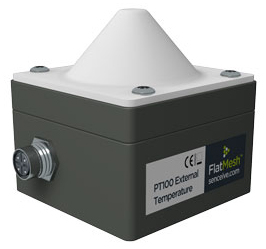
PT100 RTD Sensor Node
The PT100 RTD Sensor Node enables precise temperature monitoring and can be supplied with an integrated triaxial tilt sensor.
Here the PT100 is installed on a chimney for combined tilt and temperature sensing.
Get more information
InfraGuardTM
Wireless tilt sensors are mounted on stakes which are driven into the face of the slope. The sensors detect rotational movements and send scheduled data reports. Sudden movement events are also detected as they happen, regardless of the pre-set sampling schedule.
When pre-set thresholds are breached, sampling is accelerated and nearby nodes are triggered.
When a camera is integrated into the system, users will also get sent scheduled photos, as well as immediate photos during sudden events.
Get more information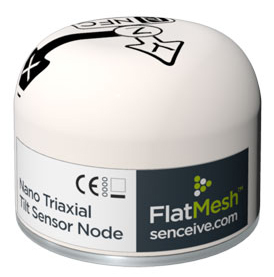
Nano Macro Triaxial Tilt Sensor Nodes
The Nano is a wireless tiltmeter that delivers precise readings of measurements of changes of rotational movement in a compact, robust enclosure, and offers NFC for user-interaction. With no external antenna, the Nano is ideal for the most challenging environments.
Here the Nano is installed on a building to measure stability.
Get more information
FlatMesh CameraHub
Solar-powered Camera with built-in EdgeHub. Clear, high-quality images day or night. Used as an integral part of InfraGuard monitoring solution. The camera can be set to take photos at regular intervals, on demand or most interestingly, when triggered by movements detected in nearby sensors.
Get more information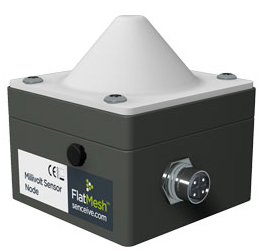
Millivolt Sensor Node
The Millivolt Sensor Node enables a variety of structural and geotechnical sensors to be integrated into a wireless monitoring system.
Here the sensor monitors for conductivity in the area around the pipe to monitor for leaks. A node cap helps protect the antenna.
Get more information
Vibrating Wire Sensor Nodes with strain gauges
The Vibrating Wire Sensor Node supports a variety of interface sensors such as crack or strain gauges and extensometers.
Here it is connected to a strain gauge to prevent the need for manual monitoring by transmitting data over a wireless network.
Get more information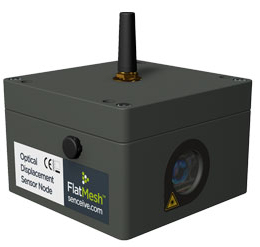
Optical Displacement Sensor Node
The ODS combines a tilt meter and a laser displacement sensor. Together they provide information about the stability of the structure the sensor is fixed to and the relative movement of a target structure.
Here the ODS measures tunnel convergence.
Get more information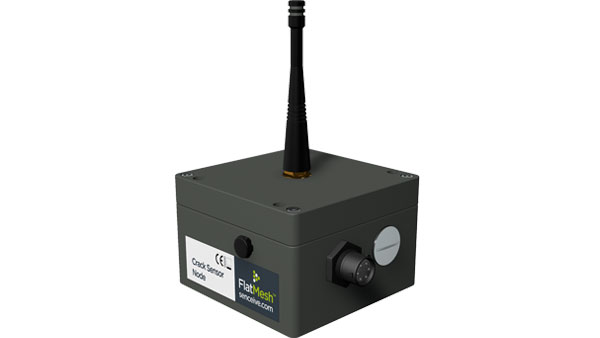
Crack Sensor Node
The Crack Sensor Node is used to monitor structural behaviour including the development of cracks in concrete or masonry, movement of expansion joints and pile separation.
Here it is monitoring the movement of a crack on the rock surface above the tunnel.
Get more information
Tilt Beams with Nano Triaxial Tilt Sensor Nodes
The Tilt Beam can be mounted in any orientation and rapidly deployed in single or daisy-chained configurations. Tilt sensor nodes fixed to beams allow movement to be assessed over a wide zone to provide a comprehensive assessment.
Here the sensors are monitoring for settlement of the bridge.
Get more information
Crack Sensor Node
The Crack Sensor Node is used to monitor structural behaviour including the development of cracks in concrete or masonry, movement of expansion joints and pile separation.
Here it is monitoring to ensure bridge joints are expanding and contracting within acceptable limits.
Get more information
Optical Displacement Sensor Node
The ODS combines a tilt meter and a laser displacement sensor. Together they provide information about the stability of the structure the sensor is fixed to and the relative movement of a target structure.
Here the ODS measures the stability of the bridge abutment as well as any lateral movement.
Get more information
Nano Macro Triaxial Tilt Sensor Nodes
The Nano is a wireless tiltmeter that delivers precise readings of measurements of changes of rotational movement in a compact, robust enclosure, and offers NFC for user-interaction. With no external antenna, the Nano is ideal for the most challenging environments.
Here Nanos are installed on catch fence supports to monitor stability of the rock face.
Get more information
Nano Macro Triaxial Tilt Sensor Nodes
The Nano is a wireless tiltmeter that delivers precise readings of measurements of changes of rotational movement in a compact, robust enclosure, and offers NFC for user-interaction. With no external antenna, the Nano is ideal for the most challenging environments.
Here the Nano is installed on a dam to measure rotational movement.
Get more information
Digital Interface Node
The Digital Interface Node is a wireless digital data logger that enables automated sampling. It is compatible with many types of sensor that carry a digital output. Interact and manage your data online and change reporting times and thresholds remotely.
Here the Digital Interface Node is connected to an inclinometer.
Get more information
FlatMesh 4G Gateway
The FlatMesh 4G Gateway provides all the functionality required to operate a wireless sensor network in a remote location. With a solar panel, no fixed power supply is required. Data is transmitted from the sensors to the Gateway. Choose whether you want to relay your data to our cloud-based portal WebMonitorTM or to third party visualisation software.
Get more information
Digital Interface Node
The Digital Interface Node is a wireless digital data logger that enables automated sampling. It is compatible with many types of sensor that carry a digital output. Interact and manage your data online and change reporting times and thresholds remotely.
Here the Digital Interface Node is connected to a piezometer.
Get more information
Digital Interface Node
The Digital Interface Node is a wireless digital data logger that enables automated sampling. It is compatible with many types of sensor that carry a digital output. Interact and manage your data online and change reporting times and thresholds remotely.
Here the Digital Interface Node is connected to a weather station.
Get more information
Vibrating Wire Sensor Node with strain gauge
The vibrating wire enables high precision and low power monitoring of a wide variety of structural and geotechnical sensors.
Here it is connected to a strain gauge.
Get more information



















 Rail
Rail
 Tunnels
Tunnels
 Flood defence
Flood defence  Bridges
Bridges
 Energy and
Energy and  Buildings
Buildings

















